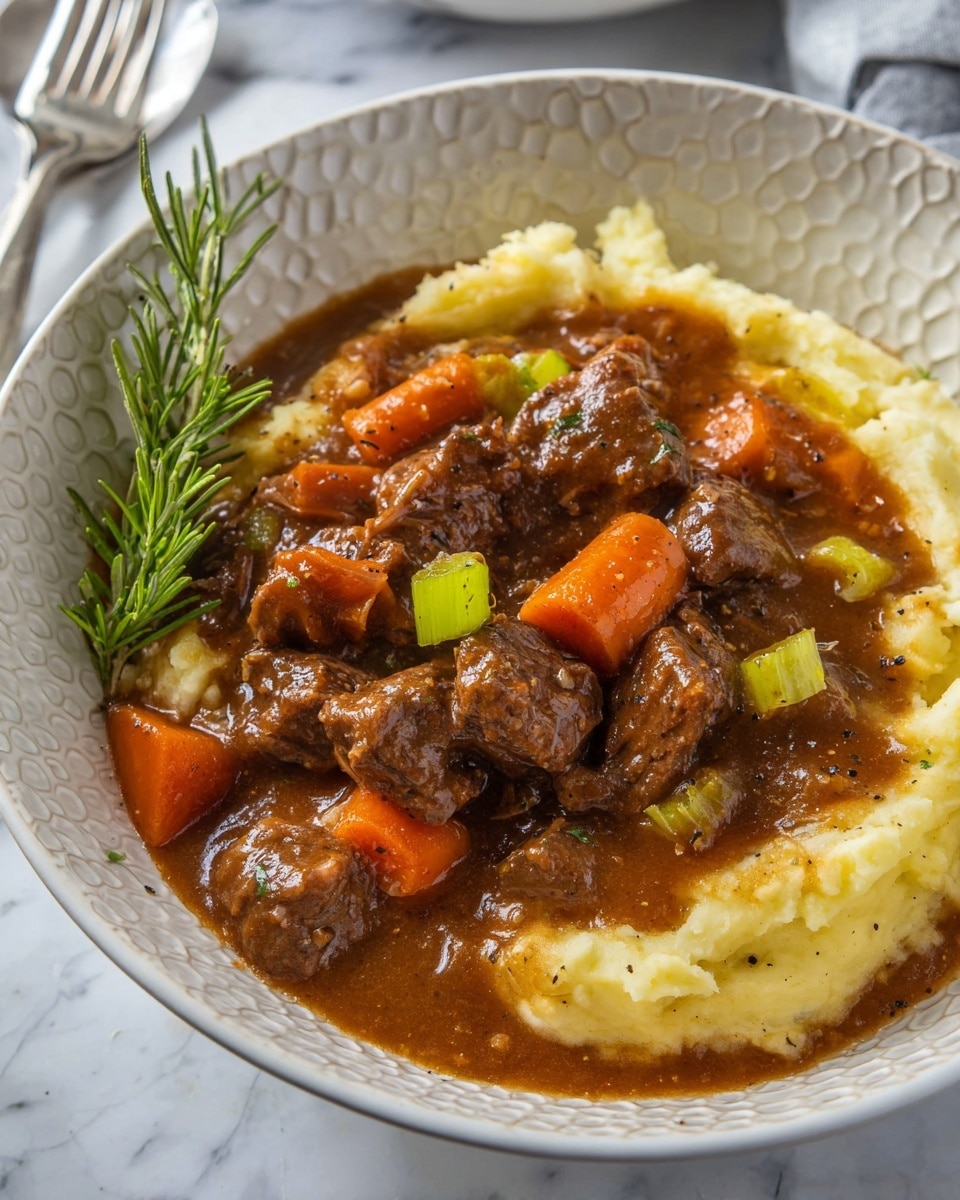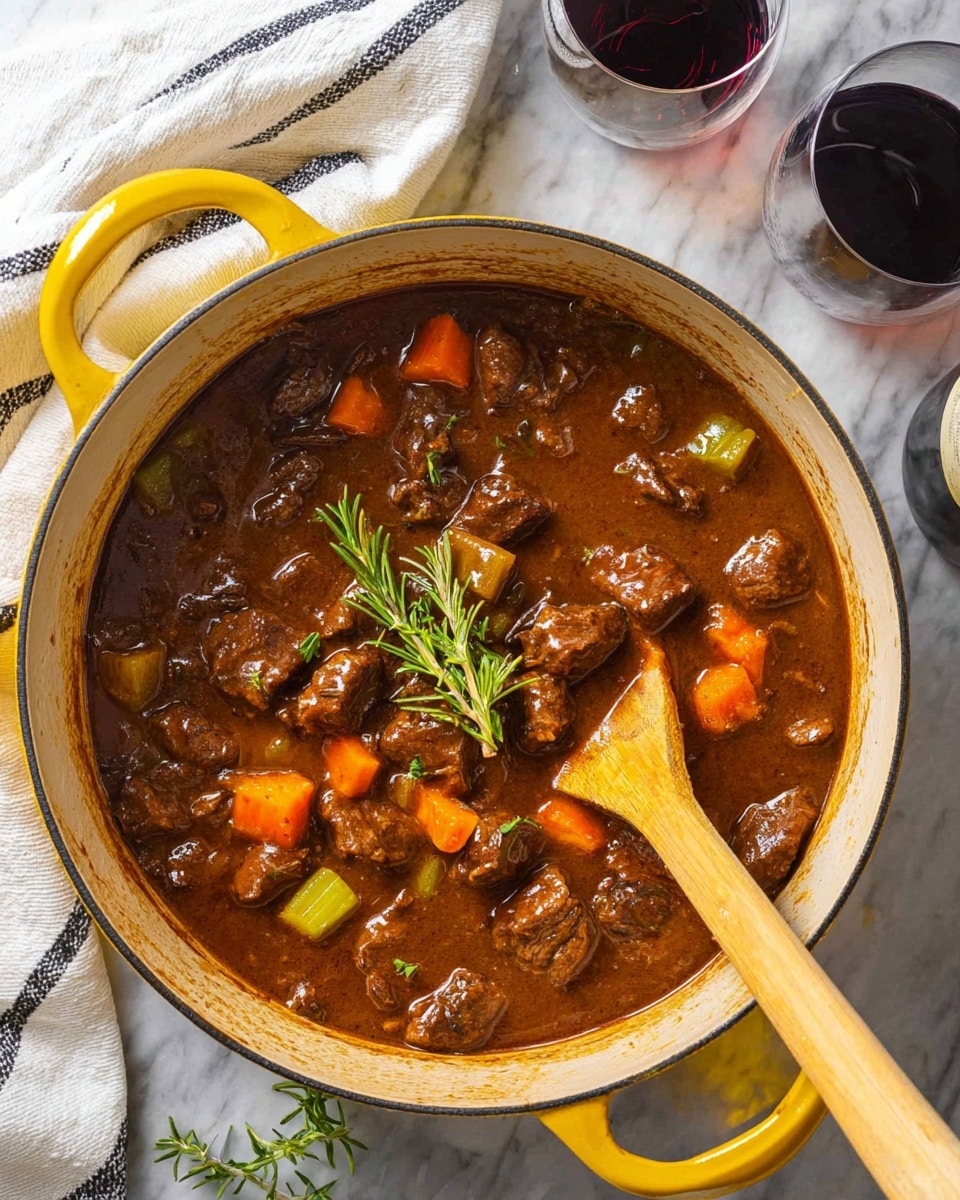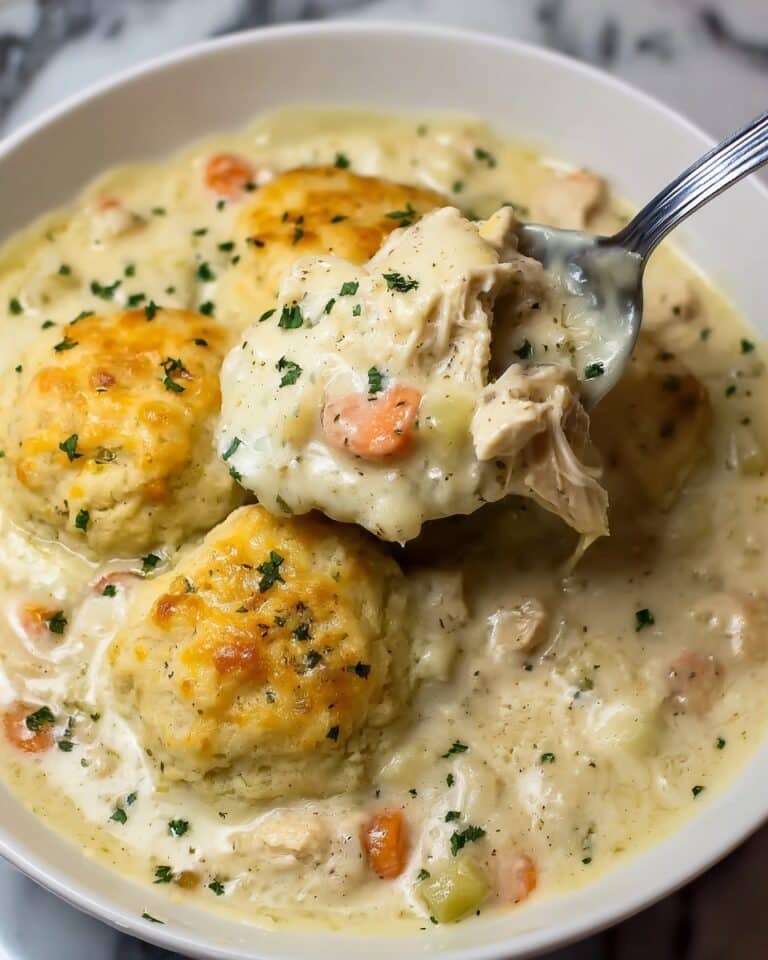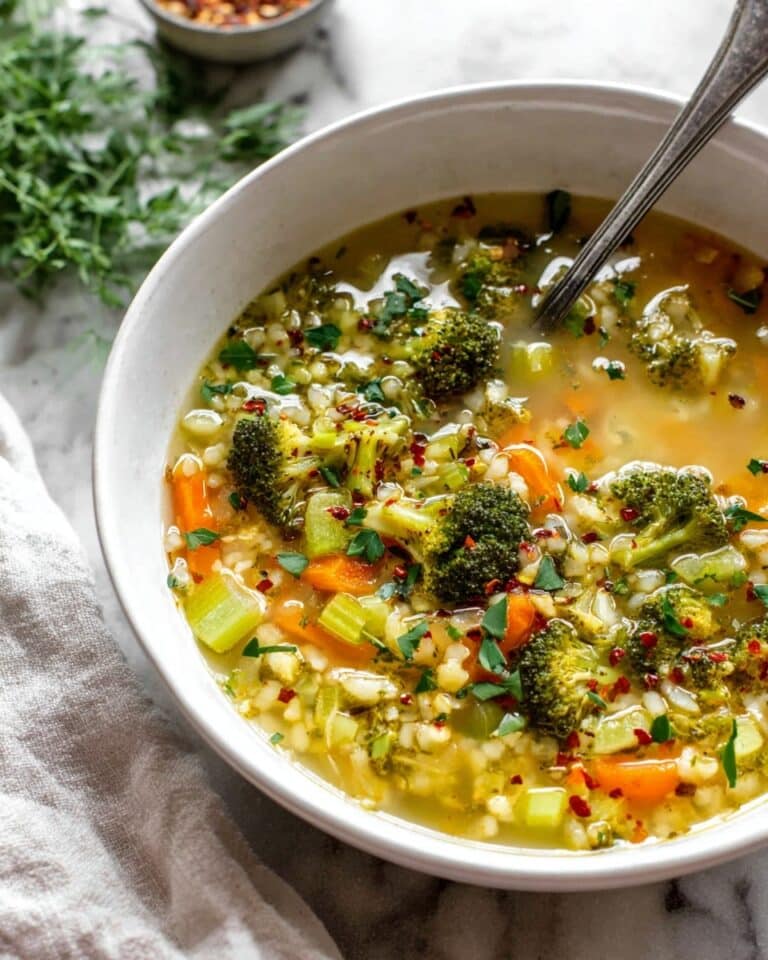Red Wine Beef Stew Recipe
If you’re looking for a hearty, comforting meal that warms your soul, this Red Wine Beef Stew Recipe is just what you need. It’s packed with tender chunks of beef slowly simmered in rich red wine and savory herbs—perfect for chilly evenings or whenever you crave something cozy and satisfying. I always find that the deep flavors develop best when it’s allowed to gently bubble away on the stove, filling the house with that mouthwatering smell.
This stew really shines because it balances the wine’s acidity with earthy vegetables and robust beef flavors, creating a dish that’s surprisingly easy to make but tastes like you’ve been slaving away all day—without the stress. Whether you’re planning a family dinner or want something that reheats beautifully for leftovers, this Red Wine Beef Stew Recipe has become a go-to in my kitchen, and I’m sure you’ll love it as much as I do.
Why This Recipe Works
- Slow Simmering: This lets the beef get incredibly tender while soaking up all the red wine and herbs’ flavor.
- Balanced Ingredients: Earthy vegetables and aromatic herbs create a stew that’s rich without being overpowering.
- Pan Deglazing with Tomato Paste & Wine: It lifts all the delicious browned bits from the pan, intensifying the stew’s depth.
- Flexible Thickening Method: You can use flour or cornstarch to get just the right gravy consistency, including a gluten-free option.
Ingredients & Why They Work
The ingredients in this Red Wine Beef Stew Recipe all come together to create layers of flavor and texture. I always recommend fresh herbs and a good quality red wine because they really elevate the dish. Plus, a mix of sweet onions, carrots, and celery gives the stew that classic base that soaks up the juices beautifully.
- Stew meat: Choose a beef chuck with good marbling for tender, flavorful bites after slow cooking.
- Coarse salt: Helps season the meat evenly and draws out natural flavors before browning.
- Black pepper: Freshly cracked adds a subtle heat and layers of depth.
- Olive oil: Provides a luscious sear on the beef without burning.
- Sweet onion: Adds natural sweetness that balances the wine’s acidity.
- Carrots: Their sweetness softens during cooking and complements the beef perfectly.
- Celery: Brings an aromatic, slightly bitter edge that enhances the stew’s complexity.
- Garlic: Gives that unmistakable savory punch most hearty stews need.
- Tomato paste: Adds acidity and helps to deglaze the pan, marrying all flavors nicely.
- Beef stock: The backbone of your stew’s liquid, rich and savory.
- Red wine: Use a dry red like Cabernet or Merlot; it tenderizes the meat and adds depth.
- Dried thyme: Earthy and subtle, it blends seamlessly with the fresh rosemary.
- Fresh rosemary: Aromatic and piney, it’s my personal favorite in stews.
- Bay leaves: Adds a fragrant hint that slowly infuses into the broth.
- All-purpose flour or cornstarch: Thickens the stew to a luscious consistency, with cornstarch as a gluten-free option.
- Water: Used to mix with flour or cornstarch for smooth incorporation into the stew.
Tweak to Your Taste
I like making this Red Wine Beef Stew Recipe my own by swapping in whatever veggies I have on hand or adjusting the herbs depending on the season. It’s super adaptable, so don’t be afraid to experiment a bit. Sometimes I add mushrooms for an earthy twist or a splash of balsamic vinegar for a richer bite.
- Variation: Adding pearl onions instead of chopped ones adds a touch of elegance and a little pop of sweetness—my family loves this twist.
- Dietary adaptation: Going gluten-free? Just swap the flour for cornstarch, and double-check your broth ingredients.
- Seasonal tweak: In winter, a handful of chopped parsnips adds lovely sweetness and texture.
- Herb twist: If fresh rosemary isn’t around, a bit of sage pairs wonderfully and provides an earthy aroma.
Step-by-Step: How I Make Red Wine Beef Stew Recipe
Step 1: Brown the Beef for Flavor That Pops
Start by patting your stew meat dry and seasoning it generously with salt and black pepper. Heat up your large Dutch oven on medium-high and add olive oil. Lay the beef chunks in a single layer without crowding the pan and sear them on all sides until they develop a deep brown crust. This step is crucial—it locks in flavors and builds the base of your stew’s rich taste. Remove the browned beef and set it aside while you cook the veggies. Don’t rush this; a good sear makes a huge difference!
Step 2: Sauté the Veggies and Build Your Base
In the same pot (don’t clean it), toss in your chopped onions, sliced carrots, celery, and minced garlic. Sauté, stirring occasionally, until everything is softened and slightly caramelized—about 5-7 minutes. Next, stir in the tomato paste and mix well, letting it cook for a minute or two. This not only deepens the flavor but also starts to lift the fantastic browned bits off the bottom of the pot.
Step 3: Add the Red Wine, Broth, and Herbs
Return the beef to the pot along with any juices that collected. Pour in the red wine and beef stock, then toss in the dried thyme, fresh rosemary sprig, and bay leaves. Bring the liquid to a boil, scraping the bottom of the pot to loosen all those flavorful bits. Then, reduce the heat to low, cover your Dutch oven, and let the stew simmer gently for about 1½ hours—or until the meat is tender enough to cut with your fork. This slow simmering is the heart of the Red Wine Beef Stew Recipe.
Step 4: Thicken the Sauce to Perfection
Once your beef and veggies are tender, whisk together the flour (or cornstarch) with water until smooth. Increase the heat to medium, and slowly stir this slurry into your stew. Keep stirring until the liquid thickens to a luscious gravy consistency—this usually takes a few minutes. Give it a taste and adjust seasoning with salt and pepper as needed, then fish out those bay leaves and rosemary sprig.
Pro Tips for Making Red Wine Beef Stew Recipe
- Don’t Skip Searing: It’s tempting to rush, but a proper sear creates the caramelized exterior that adds depth to your stew.
- Use a Quality Dry Red Wine: This isn’t just for drinking—the wine’s acidity helps tenderize meat and balance flavors.
- Low and Slow Simmering: Patience pays off—cooking gently over low heat results in meltingly tender beef.
- Avoid Over-Thickening: Add thickener gradually and watch the stew’s consistency to keep it luscious, not gluey.
How to Serve Red Wine Beef Stew Recipe
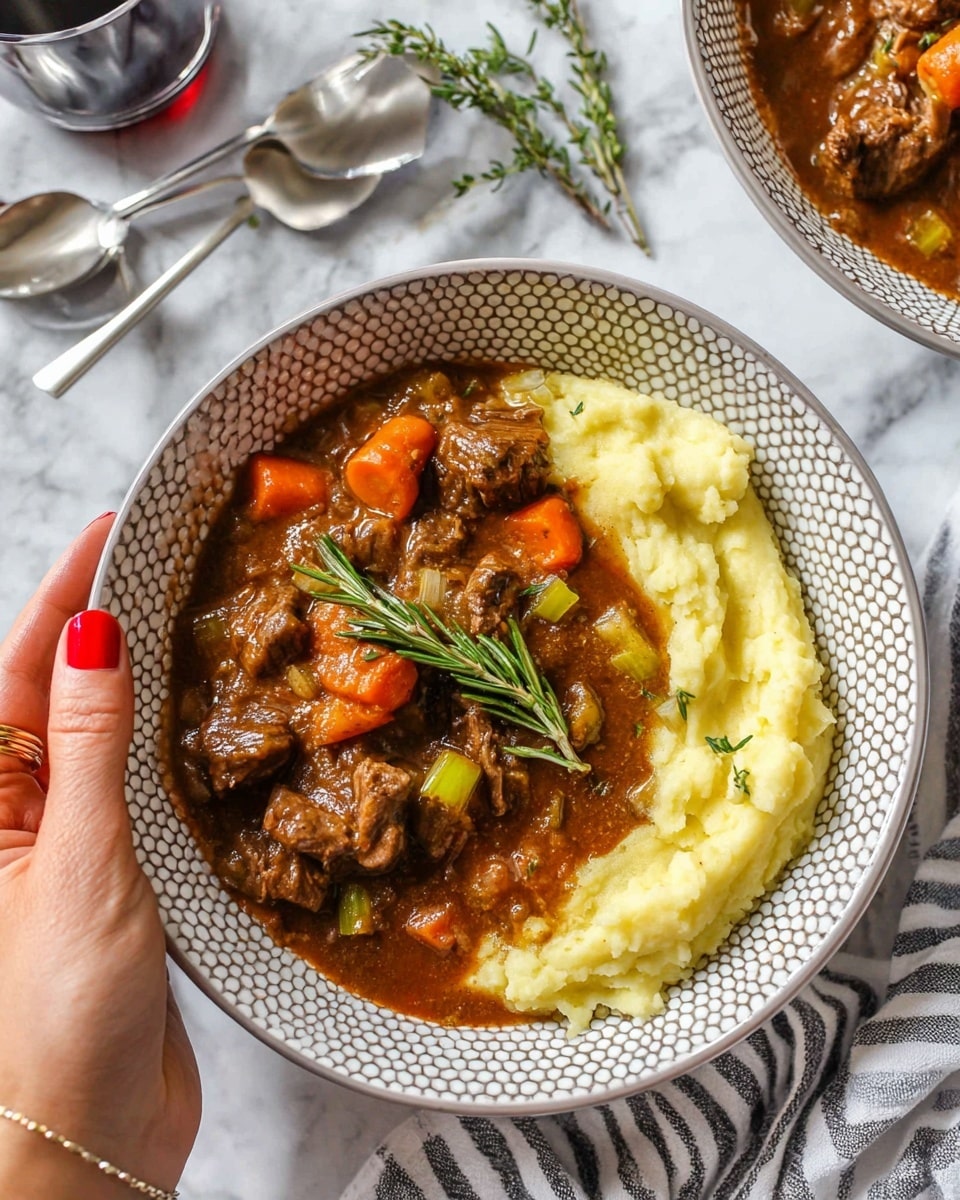
Garnishes
I always finish my Red Wine Beef Stew Recipe with a sprinkle of fresh chopped parsley or thyme—it brightens the rich stew and adds a fresh pop of color. Sometimes, I like to add a dollop of sour cream or crème fraîche for a creamy contrast, especially when serving on cold nights.
Side Dishes
This stew pairs wonderfully with creamy mashed potatoes or rustic crusty bread—you’ll want something sturdy to soak up all that luscious sauce. Roasted root vegetables or a light green salad balance the meal beautifully if you want something fresh on the side.
Creative Ways to Present
For special occasions, I love serving this stew in miniature cast iron pots or deep ramekins with a puff pastry lid to wow guests. Another fun idea is spooning it over buttery polenta or creamy grits to mix things up from the usual sides.
Make Ahead and Storage
Storing Leftovers
I store leftover Red Wine Beef Stew Recipe in airtight containers in the fridge, and it actually tastes better the next day as the flavors meld. Just make sure to cool it completely before refrigerating to keep it fresh for up to 3-4 days.
Freezing
This stew freezes beautifully! I portion it into freezer-safe containers or heavy-duty zip bags, leaving some space for expansion. When I thaw it, I pop it in the fridge overnight before reheating—super convenient for busy weeks.
Reheating
To reheat, I use a low simmer on the stovetop, stirring occasionally to prevent sticking. This helps maintain tenderness and keeps the sauce silky. Microwaving works in a pinch, but be careful not to overheat or dry out the beef.
FAQs
-
Can I use a different type of wine for the Red Wine Beef Stew Recipe?
Absolutely! While dry red wines like Cabernet Sauvignon or Merlot work best because of their depth and acidity, you can use other reds you enjoy drinking. Avoid sweet wines; they might make the stew too sugary. If you prefer white wine, the stew will have a different flavor profile but can still be delicious—just keep expectations in mind!
-
How long should I simmer the stew to ensure tender meat?
Simmering the stew gently for about 1½ hours is usually perfect for stew meat to become tender. You can go a little longer if needed—just check every 20 minutes after the hour mark. The goal is that the beef is fork-tender and breaks apart easily without falling completely apart.
-
Can I make Red Wine Beef Stew Recipe in a slow cooker or Instant Pot?
Yes! For a slow cooker, brown the meat first, then add all ingredients and cook on low for 6-8 hours. For an Instant Pot, use the sauté function to brown the meat and veggies, then pressure cook for about 35-40 minutes followed by a natural release. The result will still be delicious but may have a slightly different texture.
-
What side dishes complement this Red Wine Beef Stew Recipe best?
Mashed potatoes, crusty bread, roasted root vegetables, or a simple green salad all pair wonderfully. I especially love creamy mashed potatoes because they soak up every last bit of stew sauce—utter comfort on a plate!
Final Thoughts
This Red Wine Beef Stew Recipe has become one of my absolute favorites to whip up when I want something heartwarming and impressive without fuss. It’s the kind of meal that brings everyone to the table, warming both the belly and the soul. I hope you give it a try and make it your own little kitchen tradition—it’s worth every simmering minute, trust me!
Print
Red Wine Beef Stew Recipe
- Prep Time: 10 minutes
- Cook Time: 1 hour 30 minutes
- Total Time: 1 hour 40 minutes
- Yield: 8 servings
- Category: Main Course
- Method: Stovetop
- Cuisine: American
Description
A hearty and flavorful red wine beef stew simmered with fresh vegetables and aromatic herbs, perfect for a comforting main course.
Ingredients
Beef and Seasoning
- 2 pounds stew meat
- 2 teaspoons coarse salt
- 1/4 teaspoon black pepper
Vegetables and Aromatics
- 2 tablespoons olive oil
- 1 large sweet onion (chopped, about 2 cups)
- 4 carrots (sliced, about 3 cups)
- 2 stalks celery (sliced)
- 1 tablespoon minced garlic
- 1 tablespoon tomato paste
Liquids and Herbs
- 1 cup beef stock
- 3/4 cup red wine
- 1/4 teaspoon dried thyme
- 1 sprig fresh rosemary
- 2 bay leaves
Thickener
- 2 tablespoons all-purpose flour or 1 tablespoon cornstarch
- 1/4 cup water
Instructions
- Brown the beef: Season the stew meat with salt and pepper, then heat a large Dutch oven to medium-high heat. Sear the beef on all sides until browned. Remove the beef from the pot and set aside while you prepare the vegetables.
- Sauté the veggies: Add olive oil, onion, carrots, celery, and garlic to the pot. Cook until the vegetables are tender, about 5 to 7 minutes. Stir in the tomato paste and cook briefly to coat the veggies and deglaze the pan by scraping up the browned bits.
- Simmer the stew: Return the browned beef to the pot. Pour in the red wine and beef stock, then add the dried thyme, fresh rosemary sprig, and bay leaves. Bring the stew to a boil, then reduce heat to low and cover the pot.
- Cook until tender: Let the stew simmer gently for 1 hour and 30 minutes, or until the meat is tender and the flavors are well developed. Avoid rushing this step to ensure tender beef.
- Thicken the sauce: Whisk together the flour (or cornstarch) and water until smooth. Increase the heat to medium and stir this mixture into the stew. Continue cooking, stirring occasionally, until the liquid thickens to your desired consistency.
- Finish and serve: Adjust seasoning with additional salt and pepper if needed. Remove the rosemary sprig and bay leaves before serving. Serve hot for a comforting main course.
Notes
- Use cornstarch instead of flour and gluten-free beef broth to make this stew gluten free.
- Browning the meat thoroughly adds depth of flavor to the stew.
- Simmering the stew slowly helps the meat become tender and the flavors to meld.
- Adjust thickness by adding more water or thickener according to preference.
- Leftovers taste even better after a day as flavors develop further.
Nutrition
- Serving Size: 1 cup
- Calories: 350 kcal
- Sugar: 6 g
- Sodium: 450 mg
- Fat: 15 g
- Saturated Fat: 5 g
- Unsaturated Fat: 9 g
- Trans Fat: 0 g
- Carbohydrates: 20 g
- Fiber: 4 g
- Protein: 30 g
- Cholesterol: 95 mg

